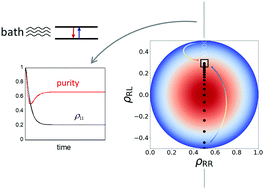Density matrix and purity evolution in dissipative two-level systems: II. Relaxation
Abstract
We investigate the time evolution of the reduced density matrix (RDM) and its purity in the dynamics of a two-level system coupled to a dissipative harmonic bath, when the system is initially placed in one of its eigenstates. We point out that the symmetry of the initial condition confines the motion of the RDM elements to a one-dimensional subspace and show that the purity always goes through its maximally mixed value at some time during relaxation, but subsequently recovers and (under low-temperature, weakly dissipative conditions) can rise to values that approach unity. These behaviors are quantified through accurate path integral calculations. Under low-temperature, weakly dissipative conditions, we observe unusual, nonmonotonic population dynamics when the two-level system is initially placed in its ground state. We also analyze the origin of the system-bath interactions responsible for the nonmonotonic behavior of purity during relaxation. Our results show that classical dephasing processes arising from site level fluctuations lead to a monotonic decay of purity, and that the quantum mechanical decoherence events associated with spontaneous phonon emission are responsible for the subsequent recovery of purity. Last, we show that coupling with a low-temperature bath can purify a mixed two-level system. In the case of the maximally mixed initial RDM, the purity increases monotonically even during short time.

- This article is part of the themed collection: 2021 PCCP HOT Articles


 Please wait while we load your content...
Please wait while we load your content...
